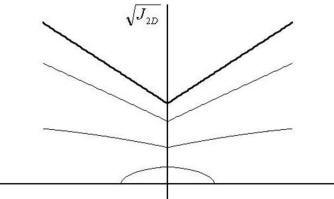|
Simple
Solutions within HiSS Due to the widespread use of HiSS
over several decades, several simple solutions were proposed within the HiSS
framework so as to mitigate certain specific issues. However, for comprehensive
resolution of all issues, the new yield function is required.
Hardening Parameters
The
existing procedure for computation of a1 and
h1 (Desai,
2001) requires plotting ln(a) vs.
ln(x). For
computing
x, only
incremental values are obtained based on test data‑points, while computation of
x0 requires
the parameters a1 and
h1. Thus
far, parameter determination has implicitly assumed
x0 to be
zero. An iterative procedure was developed in
Dube (2004) wherein
parameters are first estimated assuming
x0 to be
zero. Next
x0 is
estimated based on the parameters. The parameters are then recomputed
incorporating the
x0
estimate, and the procedure is continued till internally consistent values of
a1,
h1 and
x0
are
obtained to within the desired accuracy. Spurious Plastic Strains
The
iterative parameter determination procedure does not correct the problem of
discontinuous yield under tensile loads or spurious plastic strains under
thermal loading. Li (2002), based on the iterative parameter determination
procedure (Dube, 2004) has modified the hardening function as
Essentially, x0, which is computed based on the plasticity parameters, is now taken simply to be a material parameter, say c, rather than a component of the plastic strain trajectory. This resolves the spurious thermal plastic strain issue as c takes up any change previously attributed to x through the temperature-dependent x0. The iterative procedure for parameter determination is required to compute internally consistent values of a1, h1 and c.
However,
this again does not resolve discontinuous yield under tensile loads and lack of
an initial elastic incremental stress‑strain matrix for compressive loading in
the limit of zero stress. Discontinuous Yield For resolving discontinuous yield under tensile loads within the HiSS framework, Dube (2004) suggesting using |J1| instead of J1 in the yield function equation to provide
The
problem with this function, as shown in the plot, is that the final failure
stress also increases with increasing tensile mean pressure and the material
never fails under hydrostatic tensile mean pressure. It also does not resolve
the issue of the initial elastoplastic matrix at zero stress not being the
elastic matrix.
|

